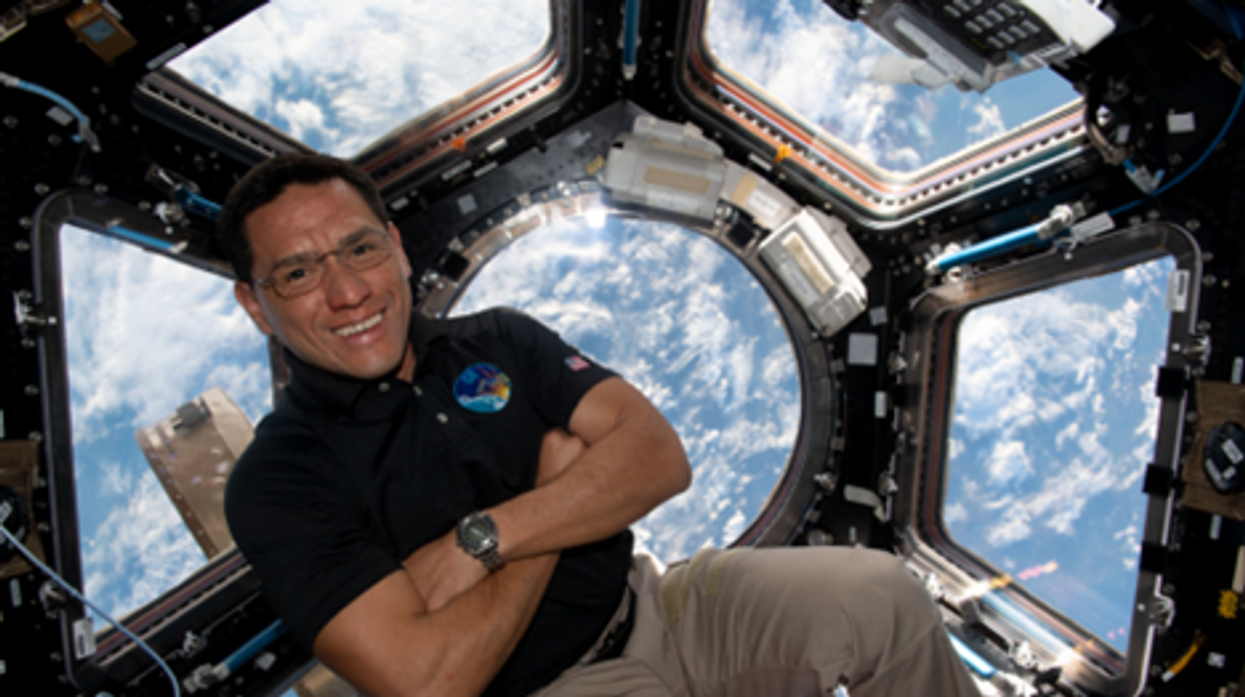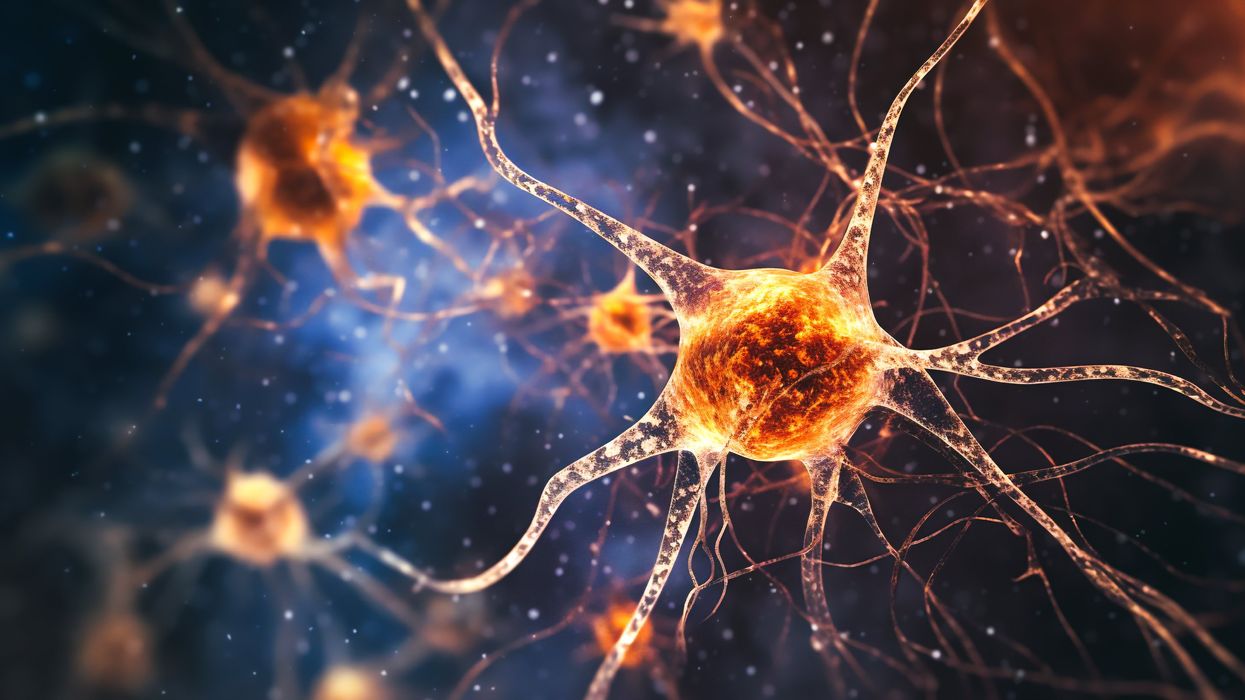Scientists discover the Achilles' heel (or head) of PFAS, cancer-causing chemicals
Lina Zeldovich has written about science, medicine and technology for Popular Science, Smithsonian, National Geographic, Scientific American, Reader’s Digest, the New York Times and other major national and international publications. A Columbia J-School alumna, she has won several awards for her stories, including the ASJA Crisis Coverage Award for Covid reporting, and has been a contributing editor at Nautilus Magazine. In 2021, Zeldovich released her first book, The Other Dark Matter, published by the University of Chicago Press, about the science and business of turning waste into wealth and health. You can find her on http://linazeldovich.com/ and @linazeldovich.
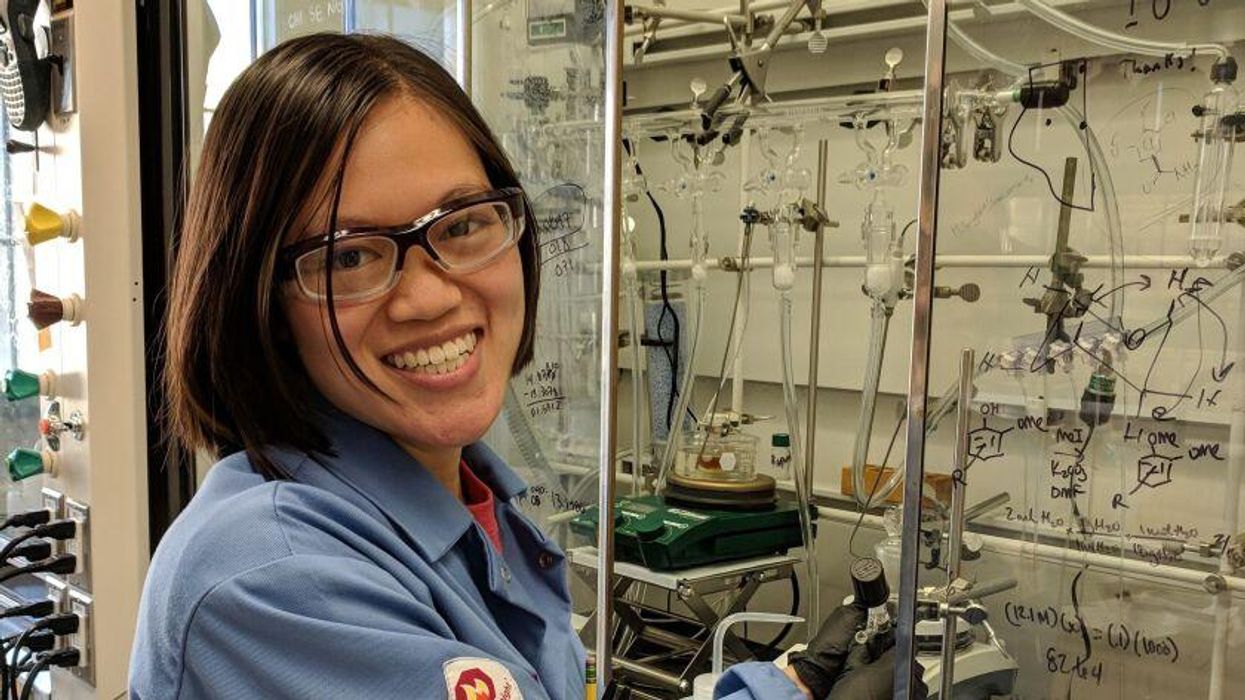
Brittany Trang led research on a new way to destroy "forever chemicals," which cause a litany of health problems, while working in William Dichtel’s chemistry lab at Northwestern University.
Brittany Trang was staring at her glass test tube, which suddenly turned opaque white. At first, she had thought that the chemical reaction she tested left behind some residue, but when she couldn’t clean it off, she realized that the reaction produced corrosive compounds that ate at the glass. That, however, was a good sign. It meant that the reaction, which she didn’t necessarily expect to work, was in fact, working. And Trang, who in 2020 was a Ph.D. researcher in chemistry at Northwestern University, had reasons to be skeptical. She was trying to break down the nearly indestructible molecules of per- and polyfluoroalkyl substances or PFAS—the forever chemicals called so because they resist heat, oil, stains, grease, and water, and thus don’t react or break down in the environment.
“The first time I ran this, I was like, oh, like there's a bunch of stuff stuck to the glass, but when I tried to clean it, it wasn’t coming off,” Trang says, recalling her original experiment and her almost-disbelief at the fact she managed to crack the notoriously stubborn and problematic molecules. “I was mostly just surprised that it worked in general.”
In the recent past, the world has been growing increasingly concerned about PFAS, the pollutants that even at low levels are associated with a litany of adverse health effects, including liver damage, thyroid disease, high cholesterol, pregnancy complications and several cancers. Used for decades in manufacturing and in various products such as fire retardant foam, water-repellant clothes, furniture fabrics, Teflon-coated pans, disposable plates, lunch containers and shoes, these super-stable compounds don’t degrade in the environment. The forever chemicals are now everywhere: in the water, in soil, in milk, and in produce.
As of June 2022, the Environmental Working Group, a nonprofit watchdog organization, found 2,858 locations in 50 states and two territories to be heavily contaminated with PFAS while many farmers had been forced to dump their milk or spinach because the levels of these compounds were in some cases up to 400 times greater than what’s considered safe. And because PFAS are so pervasive in the environment and the food we eat, they are in our bodies too. One study found some levels of PFAS in 97 to 100 percent of participants tested.
Because these compounds were made to be very stable, they are hard to destroy. So far, the only known way to break down PFAS has been to “cook” them under very harsh conditions. The process, known as pyrolysis, requires upwards of 500 degrees Centigrade, high pressure and absence of oxygen, which is energy expensive. It involves sophisticated equipment and the burning of fossil fuels. Trang, who worked in the laboratory of William Dichtel, managed to break PFAS at 120 degrees Centigrade (248 F) without using strong pressure. After she examined the results of her process with various techniques that help quantify the resulting compounds and confirmed that PFAS had indeed degraded into carbon and the corrosive fluorine that clouded her glass, she was thrilled that it worked in such simple conditions.
“That's really what differentiates our finding from everything else that's out there,” Dichtel said about their discovery at a press conference announcing the study last month. “When we're talking about low temperatures, we're at 120 degrees Celsius and sometimes even quite a bit lower than that, and especially ambient pressure.”
The process used by Trang’s team was the exact opposite of the typical organic synthesis method.
Trang’s journey into PFAS degradation began with a paper she read about the nuances of the chemicals’ molecular structure. A long molecule comprised primarily of carbon and fluorine atoms, along with oxygen and hydrogen, it has what Trang describes as a head and a tail. At the head sits a compound called carboxylic acid while the fluorine atoms make up the tail portion, with the atomic bonds so strong they aren’t possible to break without harsh treatment. But in early 2020, Trang read that a solvent called dimethylsulfoxide, or DMSO, commonly used in labs and industry, can make the carboxylic acid “pop off” its place. The DMSO doesn’t react with carboxylic acid but sort of displaces it, leaving the rest of the typically indestructible PFAS molecule vulnerable.
Trang found that its exposed fluorine tail would react with another common chemical compound, sodium hydroxide, causing a cascade of reactions that ultimately unravel the rest. “After you have decarboxylated the head, the hydroxide is able to react with the tail,” Trang says. “That's what sets off a cascade of reactions that degrades the rest of the molecule.”
That pathway took time to figure out. Trang was able to determine that the molecule carboxylic acid head popped off, but before she was able to figure out the rest, her lab and the entire Northwestern University went into lockdown in early March of 2020. “I was able to do three experiments before the shutdown,” she recalls. For the next few months, she sat at home, reading scientific literature to understand how to continue the degradation process. “I had read a bunch of literature and had a bunch of ideas for what may or may not work,” she says. By the time she could return to work, she had a plan. “I added sodium hydroxide in my batch of experiments when the lab reopened.”
The process used by Trang’s team was the exact opposite of the typical organic synthesis method. “Most organic chemists take two molecules and squish them together to make one big molecule. It’s like taking two Legos and putting them together to make one thing that was larger,” she says. “What we are doing is kind of smashing the Lego with two bits and looking at what was left to figure out how it fell apart.” The team published their discovery in the journal Science.
Although very promising, the process isn’t quite ready for industrial applications, and will take time to adapt, Trang says. For starters, it would have to be scaled up to continuously clean large quantities of water, sewage or other substances that can be contaminated with PFAS. The process will also have to be modified, particularly when it comes to removing PFAS from drinking water because as an industrial chemical, DMSO is not suitable for that. Water companies typically use activated carbon to filter out PFAS and other pollutants, so once that concentrated waste is accumulated, it would be removed and then treated with DMSO and hydroxide to break down the molecules. “That is what our method would likely be applied to,” Trang says—the concentrated waste rather than a reservoir because “you wouldn't want to mix DMSO with your drinking water.”
There are some additional limitations to the method. It only breaks down one class of forever chemicals, but there are others. For example, the molecules of perfluoroalkane sulfonic acids, or PFSA, don’t have a carboxylic head that DMSO can displace. Instead, PFSA have a sulphonic acid as their molecular head, which would require a different solvent that still needs to be discovered. “There is certainly the possibility of activating sulphonates in similar ways [to what] we've done [with] carboxylates,” Dichtel said, and he hopes this will happen in the future. Other forever chemical types may have their own Achilles’ heels, waiting to be discovered. “If we can knock that sulphonated headgroup off the molecule and get to the same intermediates we get to in this study,” Dichtel added, “it's very reasonable to assume that they'll degrade by very similar pathways.” Perhaps another team of inquisitive chemists will take on the challenge.
Lina Zeldovich has written about science, medicine and technology for Popular Science, Smithsonian, National Geographic, Scientific American, Reader’s Digest, the New York Times and other major national and international publications. A Columbia J-School alumna, she has won several awards for her stories, including the ASJA Crisis Coverage Award for Covid reporting, and has been a contributing editor at Nautilus Magazine. In 2021, Zeldovich released her first book, The Other Dark Matter, published by the University of Chicago Press, about the science and business of turning waste into wealth and health. You can find her on http://linazeldovich.com/ and @linazeldovich.
After spaceflight record, NASA looks to protect astronauts on even longer trips
NASA astronaut Frank Rubio floats by the International Space Station’s “window to the world.” Yesterday, he returned from the longest single spaceflight by a U.S. astronaut on record - over one year. Exploring deep space will require even longer missions.
At T-minus six seconds, the main engines of the Atlantis Space Shuttle ignited, rattling its capsule “like a skyscraper in an earthquake,” according to astronaut Tom Jones, describing the 1988 launch. As the rocket lifted off and accelerated to three times the force of Earth's gravity, “It felt as if two of my friends were standing on my chest and wouldn’t get off.” But when Atlantis reached orbit, the main engines cut off, and the astronauts were suddenly weightless.
Since 1961, NASA has sent hundreds of astronauts into space while working to making their voyages safer and smoother. Yet, challenges remain. Weightlessness may look amusing when watched from Earth, but it has myriad effects on cognition, movement and other functions. When missions to space stretch to six months or longer, microgravity can impact astronauts’ health and performance, making it more difficult to operate their spacecraft.
Yesterday, NASA astronaut Frank Rubio returned to Earth after over one year, the longest single spaceflight for a U.S. astronaut. But this is just the start; longer and more complex missions into deep space loom ahead, from returning to the moon in 2025 to eventually sending humans to Mars. To ensure that these missions succeed, NASA is increasing efforts to study the biological effects and prevent harm.
The dangers of microgravity are real
A NASA report published in 2016 details a long list of incidents and near-misses caused – at least partly – by space-induced changes in astronauts’ vision and coordination. These issues make it harder to move with precision and to judge distance and velocity.
According to the report, in 1997, a resupply ship collided with the Mir space station, possibly because a crew member bumped into the commander during the final docking maneuver. This mishap caused significant damage to the space station.
Returns to Earth suffered from problems, too. The same report notes that touchdown speeds during the first 100 space shuttle landings were “outside acceptable limits. The fastest landing on record – 224 knots (258 miles) per hour – was linked to the commander’s momentary spatial disorientation.” Earlier, each of the six Apollo crews that landed on the moon had difficulty recognizing moon landmarks and estimating distances. For example, Apollo 15 landed in an unplanned area, ultimately straddling the rim of a five-foot deep crater on the moon, harming one of its engines.
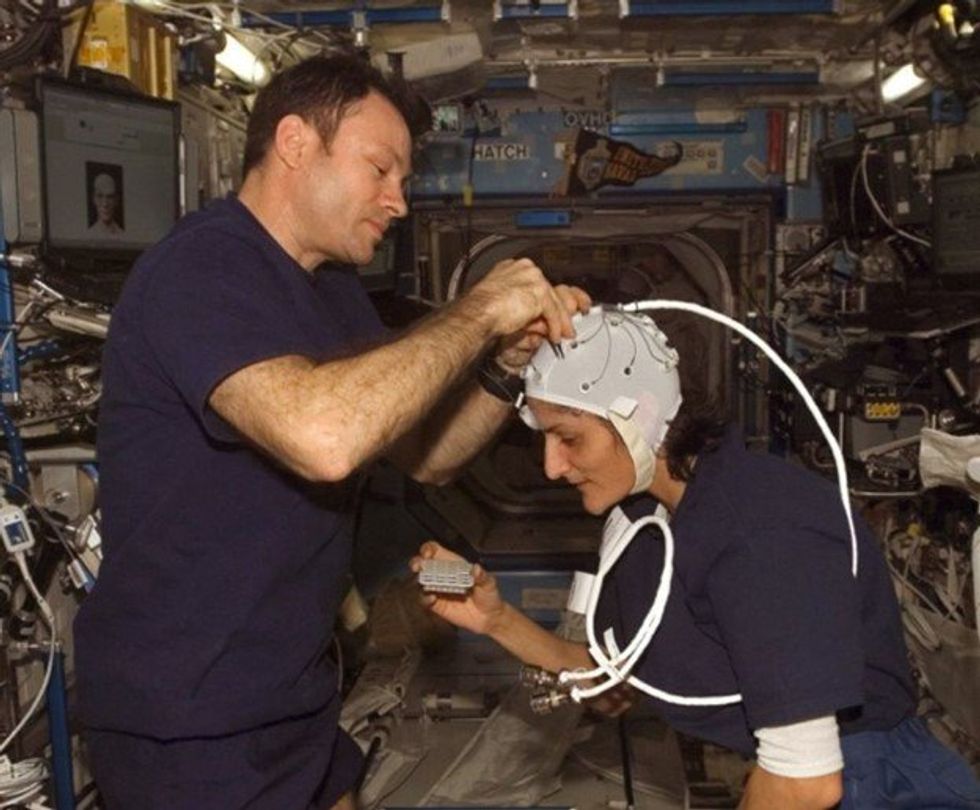
Spaceflight causes unique stresses on astronauts’ brains and central nervous systems. NASA is working to reduce these harmful effects.
NASA
Space messes up your brain
In space, astronauts face the challenges of microgravity, ionizing radiation, social isolation, high workloads, altered circadian rhythms, monotony, confined living quarters and a high-risk environment. Among these issues, microgravity is one of the most consequential in terms of physiological changes. It changes the brain’s structure and its functioning, which can hurt astronauts’ performance.
The brain shifts upwards within the skull, displacing the cerebrospinal fluid, which reduces the brain’s cushioning. Essentially, the brain becomes crowded inside the skull like a pair of too-tight shoes.
That’s partly because of how being in space alters blood flow. On Earth, gravity pulls our blood and other internal fluids toward our feet, but our circulatory valves ensure that the fluids are evenly distributed throughout the body. In space, there’s not enough gravity to pull the fluids down, and they shift up, says Rachael D. Seidler, a physiologist specializing in spaceflight at the University of Florida and principal investigator on many space-related studies. The head swells and legs appear thinner, causing what astronauts call “puffy face chicken legs.”
“The brain changes at the structural and functional level,” says Steven Jillings, equilibrium and aerospace researcher at the University of Antwerp in Belgium. “The brain shifts upwards within the skull,” displacing the cerebrospinal fluid, which reduces the brain’s cushioning. Essentially, the brain becomes crowded inside the skull like a pair of too-tight shoes. Some of the displaced cerebrospinal fluid goes into cavities within the brain, called ventricles, enlarging them. “The remaining fluids pool near the chest and heart,” explains Jillings. After 12 consecutive months in space, one astronaut had a ventricle that was 25 percent larger than before the mission.
Some changes reverse themselves while others persist for a while. An example of a longer-lasting problem is spaceflight-induced neuro-ocular syndrome, which results in near-sightedness and pressure inside the skull. A study of approximately 300 astronauts shows near-sightedness affects about 60 percent of astronauts after long missions on the International Space Station (ISS) and more than 25 percent after spaceflights of only a few weeks.
Another long-term change could be the decreased ability of cerebrospinal fluid to clear waste products from the brain, Seidler says. That’s because compressing the brain also compresses its waste-removing glymphatic pathways, resulting in inflammation, vulnerability to injuries and worsening its overall health.
The effects of long space missions were best demonstrated on astronaut twins Scott and Mark Kelly. This NASA Twins Study showed multiple, perhaps permanent, changes in Scott after his 340-day mission aboard the ISS, compared to Mark, who remained on Earth. The differences included declines in Scott’s speed, accuracy and cognitive abilities that persisted longer than six months after returning to Earth in March 2016.
By the end of 2020, Scott’s cognitive abilities improved, but structural and physiological changes to his eyes still remained, he said in a BBC interview.
“It seems clear that the upward shift of the brain and compression of the surrounding tissues with ventricular expansion might not be a good thing,” Seidler says. “But, at this point, the long-term consequences to brain health and human performance are not really known.”
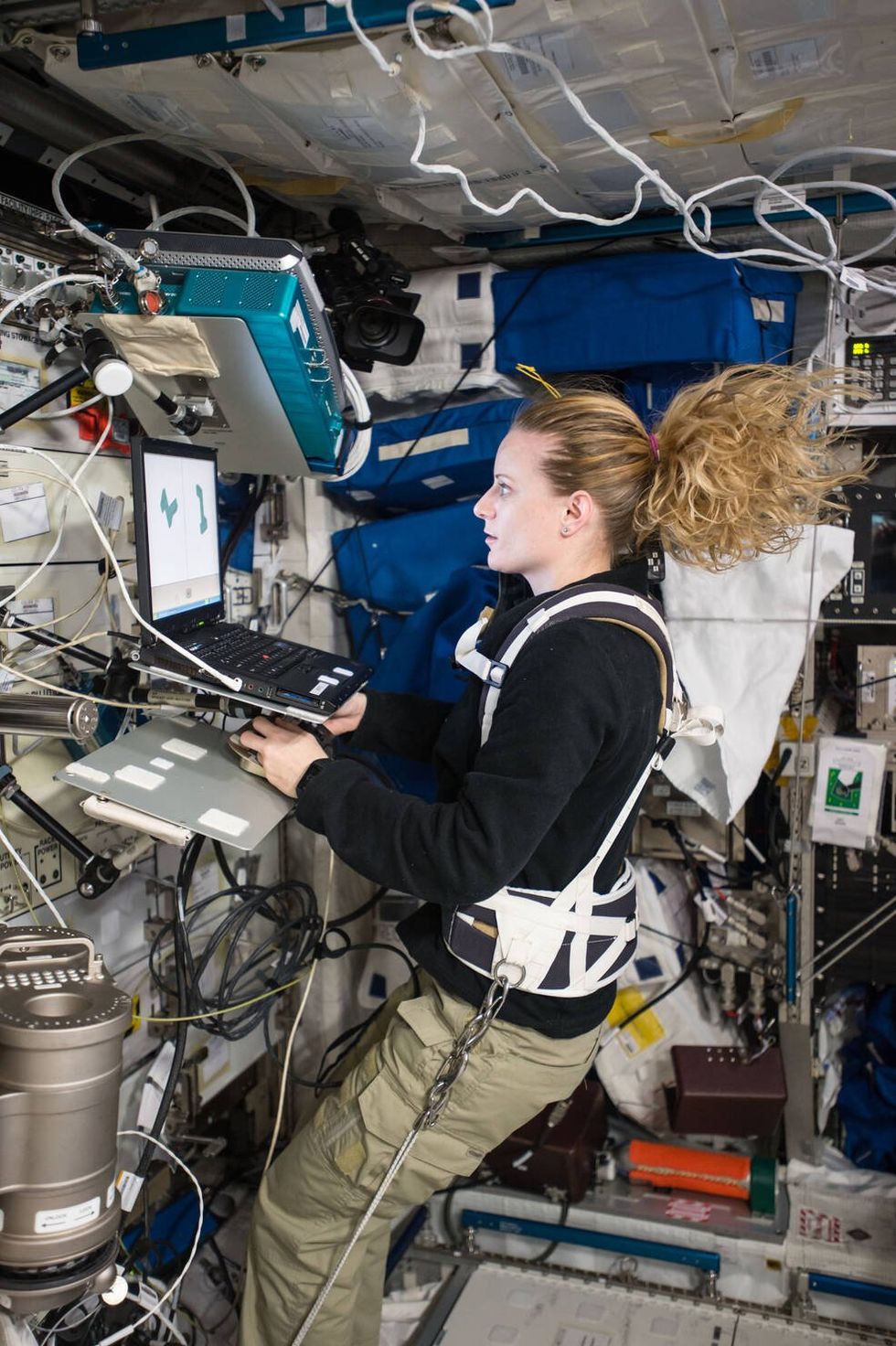
NASA astronaut Kate Rubins conducts a session for the Neuromapping investigation.
NASA
Staying sharp in space
To investigate how prolonged space travel affects the brain, NASA launched a new initiative called the Complement of Integrated Protocols for Human Exploration Research (CIPHER). “CIPHER investigates how long-duration spaceflight affects both brain structure and function,” says neurobehavioral scientist Mathias Basner at the University of Pennsylvania, a principal investigator for several NASA studies. “Through it, we can find out how the brain adapts to the spaceflight environment and how certain brain regions (behave) differently after – relative to before – the mission.”
To do this, he says, “Astronauts will perform NASA’s cognition test battery before, during and after six- to 12-month missions, and will also perform the same test battery in an MRI scanner before and after the mission. We have to make sure we better understand the functional consequences of spaceflight on the human brain before we can send humans safely to the moon and, especially, to Mars.”
As we go deeper into space, astronauts cognitive and physical functions will be even more important. “A trip to Mars will take about one year…and will introduce long communication delays,” Seidler says. “If you are on that mission and have a problem, it may take eight to 10 minutes for your message to reach mission control, and another eight to 10 minutes for the response to get back to you.” In an emergency situation, that may be too late for the response to matter.
“On a mission to Mars, astronauts will be exposed to stressors for unprecedented amounts of time,” Basner says. To counter them, NASA is considering the continuous use of artificial gravity during the journey, and Seidler is studying whether artificial gravity can reduce the harmful effects of microgravity. Some scientists are looking at precision brain stimulation as a way to improve memory and reduce anxiety due to prolonged exposure to radiation in space.
Other scientists are exploring how to protect neural stem cells (which create brain cells) from radiation damage, developing drugs to repair damaged brain cells and protect cells from radiation.
To boldly go where no astronauts have gone before, they must have optimal reflexes, vision and decision-making. In the era of deep space exploration, the brain—without a doubt—is the final frontier.
Additionally, NASA is scrutinizing each aspect of the mission, including astronaut exercise, nutrition and intellectual engagement. “We need to give astronauts meaningful work. We need to stimulate their sensory, cognitive and other systems appropriately,” Basner says, especially given their extreme confinement and isolation. The scientific experiments performed on the ISS – like studying how microgravity affects the ability of tissue to regenerate is a good example.
“We need to keep them engaged socially, too,” he continues. The ISS crew, for example, regularly broadcasts from space and answers prerecorded questions from students on Earth, and can engage with social media in real time. And, despite tight quarters, NASA is ensuring the crew capsule and living quarters on the moon or Mars include private space, which is critical for good mental health.
Exploring deep space builds on a foundation that began when astronauts first left the planet. With each mission, scientists learn more about spaceflight effects on astronauts’ bodies. NASA will be using these lessons to succeed with its plans to build science stations on the moon and, eventually, Mars.
“Through internally and externally led research, investigations implemented in space and in spaceflight simulations on Earth, we are striving to reduce the likelihood and potential impacts of neurostructural changes in future, extended spaceflight,” summarizes NASA scientist Alexandra Whitmire. To boldly go where no astronauts have gone before, they must have optimal reflexes, vision and decision-making. In the era of deep space exploration, the brain—without a doubt—is the final frontier.
A newly discovered brain cell may lead to better treatments for cognitive disorders
Swiss researchers have found a type of brain cell that appears to be a hybrid of the two other main types — and it could lead to new treatments for brain disorders.
Swiss researchers have discovered a third type of brain cell that appears to be a hybrid of the two other primary types — and it could lead to new treatments for many brain disorders.
The challenge: Most of the cells in the brain are either neurons or glial cells. While neurons use electrical and chemical signals to send messages to one another across small gaps called synapses, glial cells exist to support and protect neurons.
Astrocytes are a type of glial cell found near synapses. This close proximity to the place where brain signals are sent and received has led researchers to suspect that astrocytes might play an active role in the transmission of information inside the brain — a.k.a. “neurotransmission” — but no one has been able to prove the theory.
A new brain cell: Researchers at the Wyss Center for Bio and Neuroengineering and the University of Lausanne believe they’ve definitively proven that some astrocytes do actively participate in neurotransmission, making them a sort of hybrid of neurons and glial cells.
According to the researchers, this third type of brain cell, which they call a “glutamatergic astrocyte,” could offer a way to treat Alzheimer’s, Parkinson’s, and other disorders of the nervous system.
“Its discovery opens up immense research prospects,” said study co-director Andrea Volterra.
The study: Neurotransmission starts with a neuron releasing a chemical called a neurotransmitter, so the first thing the researchers did in their study was look at whether astrocytes can release the main neurotransmitter used by neurons: glutamate.
By analyzing astrocytes taken from the brains of mice, they discovered that certain astrocytes in the brain’s hippocampus did include the “molecular machinery” needed to excrete glutamate. They found evidence of the same machinery when they looked at datasets of human glial cells.
Finally, to demonstrate that these hybrid cells are actually playing a role in brain signaling, the researchers suppressed their ability to secrete glutamate in the brains of mice. This caused the rodents to experience memory problems.
“Our next studies will explore the potential protective role of this type of cell against memory impairment in Alzheimer’s disease, as well as its role in other regions and pathologies than those explored here,” said Andrea Volterra, University of Lausanne.
But why? The researchers aren’t sure why the brain needs glutamatergic astrocytes when it already has neurons, but Volterra suspects the hybrid brain cells may help with the distribution of signals — a single astrocyte can be in contact with thousands of synapses.
“Often, we have neuronal information that needs to spread to larger ensembles, and neurons are not very good for the coordination of this,” researcher Ludovic Telley told New Scientist.
Looking ahead: More research is needed to see how the new brain cell functions in people, but the discovery that it plays a role in memory in mice suggests it might be a worthwhile target for Alzheimer’s disease treatments.
The researchers also found evidence during their study that the cell might play a role in brain circuits linked to seizures and voluntary movements, meaning it’s also a new lead in the hunt for better epilepsy and Parkinson’s treatments.
“Our next studies will explore the potential protective role of this type of cell against memory impairment in Alzheimer’s disease, as well as its role in other regions and pathologies than those explored here,” said Volterra.
